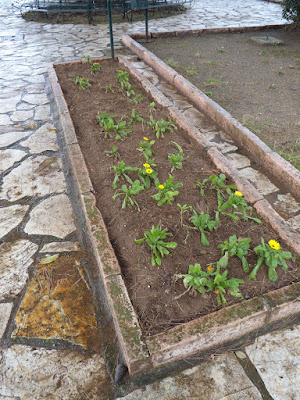Monday, 8 February 2010
Visit Monday Feb 8
The magnificent banyan tree on the right of path: at least one branch overhanging the path be removed. Two water lily ponds on the left are an eyesore. Outer rim has pockets of soil ready to grow something in. If to be kept, a few roots of trailing rosemary be planted in them in order to drape over the sides and also cover the cement base. Remove brick-edged flower beds in order to make the pathways less cramped. They also grow well in full sun or the deepest shade, They are a true Greek native and flower all over Greece from March to June. Myrtle is another evergreen shrub growing in woodland areas throughout the Mediterranean region. It tolerates shade and left on its own it will grow into a dense shrub up to 2½ metres high, but can be clipped down to any size; in season the small sweet scented flowers make the whole shrub aromatic. It is a classical, legendary plant, a symbol of leave, peace and honour. Wreaths of it were worn by magistrates and victors in the Olympic games and the flowers are still an essential addition to wedding bouquets. Remedies based on myrtle were recommended by Dioscorides for many ailments – the fine grained wood is hard and heavy and is used for small furniture and marquetry. Lavender is another aromatic plant which needs no further attention once established. It does best in an open sunny position and can also make an attractive low hedge. Liriope, named after one of the sea nymphs and the mother Narcissus, is a very good edging plant, forming dense masses of dark evergreen shiny leaves, arching and grassing from which sprout spikes of tiny mauve flowers, which can be easily pulled out when flowering is over. Oleander should be planted in any sunny spot. It is a true Greek native, evergreen and flowering all summer. It can grow to the size of a small tree or can be clipped into a bush and is at its best near the sea and comes in all shades of pink, red, white and very attractive peach and pale yellow colours. Please note: All parts of the plant are poisonous – even goats avoid it, but as it does not produce berries or fruit of any kind, its virtues outweigh its faults. The Children’s Playground Area: Plenty of benches for parents but no shelter from the sun. Build simple bamboo pergola over the benches at each corner. A climbing plant could be trained over the top In spite of the generally dark and gloomy effect of the main garden, the children's playground area has no shade at all for parents and carers - nor are there any seats for them. As metal benches clutter up the paths of the garden space, I suggest two, if not three, of them be moved to the north border and a bamboo pergola be erected around each, a small flowering tree, oleander or a citrus be planted behind. There should be adequate space behind and on either side of the bench for picnic paraphernalia and shopping bags. All plants mentioned in this report can be supplied from my own garden, also any amount of bamboo that is necessary. My gardener is quite experienced in working with bamboo if the municipal gardeners do not understand it. My aim for this garden is for it to be representative of the truly indigenous Greek flora, especially of this region, and if they have classical or historic references, so much the better. Extend fence round front entrance for privacy. Plants I can supply: Teucrium fruticans is another attractive small shrub which can grow to 2m or can be clipped to any compact size and is often used as hedges. The Playground Area: Benches but no shelter. Simple bamboo pergola to be constructed at each corner.


 Teucrium fruticans is another attractive small shrub which can grow to 2m or can be clipped to any compact size and is often used as hedges. Its all-over effect is an airy twiggy pale grey rounded bush up to 2m if left unpruned. It is mentioned and recommended by Dioscorides as a decoction against bites from venomous beasts and also for stomach ache, fevers and colds, given in baths.
Teucrium fruticans is another attractive small shrub which can grow to 2m or can be clipped to any compact size and is often used as hedges. Its all-over effect is an airy twiggy pale grey rounded bush up to 2m if left unpruned. It is mentioned and recommended by Dioscorides as a decoction against bites from venomous beasts and also for stomach ache, fevers and colds, given in baths.Feb 8 Checklist Summary
Subscribe to Comments [Atom]

Post a Comment